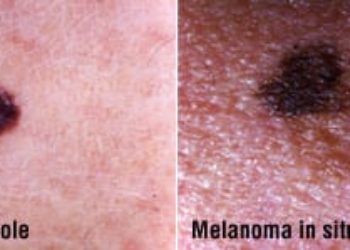Tech-aided surveillance of patients at high risk for melanoma aids early diagnosis
1. Use of total body photography (TBP), dermoscopy and sequential digital dermoscopic imaging (SDDI) in 6-month intervals detected melanomas at early stages in patients at extreme risk.
2. The few melanomas which were identified with a Breslow Depth of >1mm of thickness, were not pigmented or were rare subtypes, strengthening the need for hypervigilance and awareness by practitioners of the prevalence of these rare subtypes, especially within the high-risk population.
Evidence Rating Level: 1 (Excellent)
Study Rundown: In patients with a personal history of melanoma, there is a 9-fold elevated risk of developing subsequent melanomas. However, the role of TBP and SDDI in routine screening of such patients is unknown. This prospective study was one of the first aimed at following patients in the high-risk category to assess the impact of follow-up screening with diagnostic interventions. Investigators showed that the cumulative melanoma risk at year 4 in these patients was 18.2%, and technology associated-surveillance was able to capture 61 non-baseline incident primary melanomas during follow-up visits, 91% of which were ≤1mm in Breslow Depth. The study’s strengths were the prospective study design with adequate follow-up time. Given the stringent inclusion criteria of patients’ within the high-risk population, this study was limited in its applicability to the population at large.
Click to read the study in JAMA Dermatology
Relevant Reading: Melanoma Surveillance in High-Risk Individuals
In-Depth [prospective cohort]: In this study, 311 patients at high-risk for melanoma were observed for a median follow-up of 3.5 years with high-risk patients defined as patients with personal history of melanoma and dysplastic nevus syndrome, extensive family history of melanoma, or genetic mutations in CDKN2A and CDK4. At each 6 month visit, patients had a full skin exam and baseline TBP with subsequent dermoscopic evaluation of suspicious lesions. Suspicious lesions were excised, monitored with SDDI, or compared with previous imaging. Patients were also given copies of their baseline TBP and were told to perform self-exams at 3 and 6 months. The Kaplan Meier method was employed to calculate the cumulative incidence curve of the time to first new melanoma event. 770 lesions were excised, of which 291 (38%) were found to be malignant; 75 of these were primary melanoma skin cancers of which 61 were detected at follow-up visits after the initial visit. The overall rate of melanomas identified per study year was .08 with highest rate of detection in the multiple primary melanoma cohort being 0.11.
More from this author: Indoor tanning linked to high skin cancer risk in US and abroad, Free drug samples may alter prescription habits of dermatologists, Atopic dermatitis may be more persistent than previously understood
Image: PD
©2012-2014 2minutemedicine.com. All rights reserved. No works may be reproduced without expressed written consent from 2minutemedicine.com. Disclaimer: We present factual information directly from peer reviewed medical journals. No post should be construed as medical advice and is not intended as such by the authors, editors, staff or by 2minutemedicine.com. PLEASE SEE A HEALTHCARE PROVIDER IN YOUR AREA IF YOU SEEK MEDICAL ADVICE OF ANY SORT.


![2MM: AI Roundup- AI Cancer Test, Smarter Hospitals, Faster Drug Discovery, and Mental Health Tech [May 2nd, 2025]](https://www.2minutemedicine.com/wp-content/uploads/2025/05/Untitled-design-350x250.png)






